Posts Tagged ‘Tamil History/Culture’
Thaalam 2017 Greetings – TDSB Trustee Parthi KandavelBy Editor - July 11th, 2017 |
 |
|
I would like to extend my support to the Canadian Tamil Youth Alliance (CTYA) and their valued work. CTYA is a non-profit organization that includes many Tamil youth clubs in the GTA and across Canada, creating opportunities and events for Tamil youth so that they may realize their life’s potential and contribute to all that Canada has to offer. |
Structural Violence and Structural Genocide: Building a feminist framework of national oppression and national liberationBy Admin - December 22nd, 2014 |
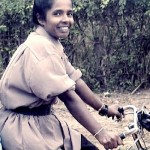 |
|
Written By: Jessica Chandrashekar and Roshni Raveenthiran The following is a discussion that emerged out of a conference that dealt with questions of feminisms and structural violence in contexts of war, authoritarianism and genocide. We focus on the presentation that Tasha Manoranjan gave titled “Gendered Genocide: Sri Lanka’s War Against Tamils”. The purpose of this piece is to share what we learned from Tasha’s talk, as well as our thoughts on structural violence and the Tamil genocide. By naming violence as ‘structural’ we are showing how violence is more than just one individual harming another individual. Violence is made possible and enabled by institutions such as the legal system, the state and the media. These institutions are created or structured so that some people gain certain privileges and protections, while other people are oppressed. We want to open up a discussion about the structural dynamics of the Tamil genocide. We feel that this discussion is important and necessary, particularly in our current context. In this current moment the UN OISL is writing their report and will make recommendations to the international community; there are debates on dropping the term ‘genocide’; and Eezham Tamils- particularly those in the Vanni, are struggling against colonization and military occupation. The month in which we began our discussion is significant because our conversations on structural violence and the Tamil genocide took place during November. November is the month of Maaveerar Naal, a day of remembrance of those who sacrificed their lives for the freedom and liberation of Eezham Tamils. As such, we discussed three questions and below we share with you our collective thoughts. [read more inside] |
Waiting For DawnBy Admin - November 17th, 2014 |
 |
|
Written By: Keera Ratnam That day has not yet come. My people, the Tamil people, and I have been suffering from physical and mental torture. We’ve been stripped our rights and privileges – and have become muted. Despite all the suffering, we are not able to speak our voices. Why, you may ask? Why we have not spoke out? But the truth is, we are not allowed to speak. And when we do try to let our voices be heard, it is silenced. From the tiniest quarrel from our youngest living to the last standing alive. But do not worry, my brothers and sisters are not hopeless. We too believe that we will be free one day. We left our homes, family and dreams in search of a new day and to bring a day of light to our people. We are the children of today, we must work to give light to the ones that will rise tomorrow. We took oath. An oath to fight till the end, and we must vow to fight, from dawn till dusk, until a new horizon is risen. We walked many miles, up many hills, dug many bunkers, fled from forest to forest, and fled from house to house. We held on to every mother and father, and promised to protect them as our own. We watched our friends cry in pain, fall within our arms asking us to hold on tight, tighter. We carried the dead, to put them to rest, and took them home for their families to see. Mothers yelled, cried and fell down to their feet. Asking their child’s body if they can have the one last chance to meet, talk, hug. Many of us lost arms and legs. Many lost their lives and some gave up their livelihood. They did not rest, they did not stop, they went on as each fighter fell. As death came closer, they said, beneath the ground we shall go, but will up-rise again as young springs and continue on with our journey until the rays of sunlight from tomorrow shines upon us with delight. From Dawn till Dusk we shall not sleep, beneath the ground we shall not rest, until the day has come for the birth of our nation. |
Spice Garden: Jeerakam (Cumin)By Admin - July 5th, 2014 |
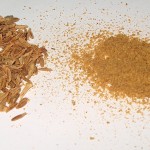 |
|
Written By: Kayalvizhi J. Welcome to Spice Garden! Love Tamil food? Me too. I’ve always been attracted to the aromas, fragrance and textures of spices, the way the flavours just blend and intertwine and the way we serve our food and by the repertoire of herbs and spices we use for healing. Last time we looked at the spice, milagu. Today we will be looking at jeerakam (cumin). Quick Benefits: Cumin seeds are used in Tamil foods whole or ground, and is a main ingredient in many curry dishes. Although small, these seeds pack intense flavor and have a peppery taste. The flavor and aroma of cumin seeds are best brought out when they are slightly roasted. They have a variety of benefits as listed above. One way to enjoy the benefits of cumin is through cumin tea. Cumin tea To make cumin tea, you need 2 teaspoons of coarsely pounded cumin and 1 cup of water. Boil the water, and add it to the cumin seeds and let this steep for 5minutes. Strain the liquid and drink it. (Yes, the taste isn’t the best, but this is beneficial!). Is there a particular spice you want to learn more about? Leave a comment and I’ll try to include it in the coming weeks. Until next time, enjoy your tea! =) Disclaimer: This blog provides general information and discussion about medicine, health and related subjects. The words and other content provided in this blog, and in any linked materials, are not intended and should not be construed as medical advice. If the reader or any other person has a medical concern, he or she should consult with an appropriately-licensed physician or other health care worker. |
Spice Garden: Milagu (Black Peppercorns)By Admin - June 10th, 2014 |
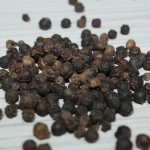 |
|
Written By: Kayalvizhi J. Welcome to Spice Garden! Love Tamil food? Me too. I’ve always been attracted to the aromas, fragrance and textures of spices, the way the flavours just blend and intertwine and the way we serve our food and by the repertoire of herbs and spices we use for healing. Our cooking is not only tasty, but beneficial for the body. The levels of obesity and disease in all communities is increasing, but we can prevent this by adopting more of our ancient healing into our cooking. Your grandma and mom have a good knowledge of home remedies and recipes made with a variety of herbs and spices to promote healing and maintain good health. And we, the younger Tamil youth should also become knowledgeable about these things, and this blog is an attempt to impart some knowledge about Tamil spices, herbs and recipes. While I may be biased saying Tamil cuisine is the tastiest in the world, the world has also noticed. Tamil cooking has been praised all around the world, and Tamil cooking influences can be seen in other cuisines, and in the English language. For example, the English word ‘Curry’ is derived from the Tamil word, Kari, ‘Mango’ from Maangai, ‘Conjee’ from Kanji, Ginger from Inchiver. Tamil Sangam literature and epigraphs chiseled in walls of ancient Tamil temples have also recorded information about the benefits and preparations of Tamil herbs and spices. Today we will be looking at the spice, milagu also known as yavanappiriyam (black peppercorns). Quick Benefits: – Digestion If you’ve had Tamil food, it is likely it would have had some black pepper corns in it. Peppercorns are added to many savoury dishes, especially to meat and chicken. Black pepper helps in digestion and its aromatic flavour helps flavour in meat and poulty dishes while helping masking ‘meaty’ smells (especially when mixed with garlic). Pepper is ground when used in dishes. Pepper is also used in home medicine to treat coughs, colds, fevers, asthma and constipation. A mixture of salt and pepper with caraway leaves used as a gargle can help fight cough. In many cultures, you may have notices certain soups are eaten as appetizers before means to increase appetite. In Tamil cuisine, rasam acts as the appetite stimulant and includes black peppercorns. Rasam can be consumed at different periods in a meal; eating rasam before meals is to induce appetite, while eating it after is to promote digestion. It is the pepper in the rasam that contributes to both these benefits. So next time you are making a meat dish, try to sprinkle some peppercorns into it. |
Vasuki: The Story of a Young Eelam Tamil GirlBy Admin - May 8th, 2014 |
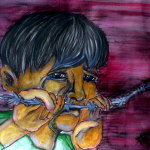 |
|
May we remember. The month of May creates a sense of calmness, the calmness that follows terror and torture. Here, we present to you, a collection of life incidents, compiled by Anbu from eyewitness accounts. They represent thousands of other stories that have been left untold. Please be advised that these stories contain materials that may be unsuitable for some readers. You may continue to read at your own discretion. The real names of the author and characters in these short stories are not available to public at the moment. Thazhumbkam is obliged to protect the identities of the people involved in these stories and their relatives whom may be in danger should their identities be revealed. Thazhumbakam is a Tamil Genocide Memorial Museum initiated by the Human Rights Advocacy Council of Canadian Tamil Youth Alliance. Painting by Keera Ratnam Vasuki: The Story of a Young Eelam Tamil Girl There was barely any food left. Starvation, exhaustion and the barrage of artilleries continued on as we feared for our lives. One morning, my mother and my aunt came out of the bunker to help my aged grandmother with her morning routines. Myself (age 13), my sister (age 10) and my brother (age 6) and my cousins aged 4 and 1 and my father stayed inside the bunker. My uncle had died in an air attack on Vaddakachchi last year. So, my aunt left her young children with us and went along with my mother outside the bunker to help my grandmother. As they were outside, a shell fell close to our place and my father peeked out of the bunker and called my mother. My mother and aunt were trying to help grandmother who was unable to run back to the bunker. Just then, another shell blasted closer to our bunker. The continuous barrage of shells continued for a few minutes. We ran outside after the blasts died down. We saw flesh strewn around the bunker. I kept my hands on my mother’s chest. It was a huge hole. My aunt’s head was chopped off. Blood was oozing from my grandmother’s ears. Many others were dead. Shelling continued. We hugged our mother’s body tight and we wept. Father and all of us wept in the bunker. My little cousins could not figure out what had happened to their mother and they cried in fear as well. All five of us were now alone with our father. We stepped out of the bunker after four hours and buried them in a place near the bunker. |
Thangachi’s Corner: Dance CultureBy Admin - March 26th, 2014 |
 |
|
Updated every other Wednesday, “Thangachi’s Corner” is a bi-monthly feature that discusses relatable topics and issues relevant to the Canadian Tamil youth of today. For more information about this feature or to suggest a topic, feel free to e-mail us at blogs@ctya.org! Written By: Keerthana Raveendran When most people talk about their love of dance, they make it sound as if it were love at first sight. As if it were an instinct that sprung to life at first step—almost as if the art form was a part of their very being. But when I first started learning dance at the age of four, I absolutely hated it. Back then, in the nineties, every Tamil girl had to learn how to dance. It was just the thing, though I couldn’t for the life of me understand the beauty of the form. After all, it was hard to feel graceful when it felt like my muscles were being torn apart slowly. And as a kid enrolled in Bharathanatyam classes with about twenty other girls, standing in a row and stomping my feet to the beat of an angry lady hitting a wooden stick on a plank didn’t seem like much fun. And I wasn’t the only one either. In fact, I distinctly remember being in a particular group of friends at dance class at around the age of nine, and the one thread that brought us all together was that fact that we just couldn’t wait to quit. Really, no joke. When one of us did finally manage to quit, when one of us didn’t show up to class for the next few weeks, the rest of us would experience an unpleasant mixture of jealousy and reluctant fascination. In any case, I was never one of those lucky few—no, my dance history went on for years (mostly because much choice wasn’t allotted where that was concerned), and I grew up slowly coming to terms with the fact that I was in it for the long run. It wasn’t until much later that I became invested in dance culture. Was it the performance aspect, do you wonder? Did I perhaps enjoy adorning that gorgeously crafted traditional attire and showcasing my hard-earned skills before a crowd? Nope—performance was my nightmare. But if you asked a dancer what about the art form they loved, they would all give you a different answer. And for me, it was the history that never failed to fascinate. Sure, I enjoyed the crisp visual aesthetics, and I came to appreciate the harsh movements which became a stress reliever long before I realized I needed one. I even loved the aspect of choreography, and would find myself drift off to random music during long bus rides before catching myself choreographing steps to the tune in my mind. But I suppose I liked most the idea of being linked to people well before my time. I liked learning about the evolution of dance over the years, and feeling a sort of connection to these ancestors I will never get a chance to meet. I don’t think I expected for dance to become such an integral part of my life. I’m not sure if anyone does at that age—it’s just something that sneaks up on you. But in light of the successful execution of CTYA’s recent Thaalam 2014, it’s hard to ignore the element of dance when defining our Tamil culture. After all, culture isn’t simply limited to language or festivities—the arts too play a key role in shaping our identity as a society. As renowned Bharathanatyam icon Smt. Rukmini Devi once said, “Dance is a very difficult art to muster, not merely because it has so much to do with physical movements but because the responsibility of the artist is far greater in this art than in any other.” Perhaps that’s also what makes the form worthwhile. A history in dance is not something that just goes away, even years after your last class. It’s in your brain every time you listen to a particularly captivating beat. It’s in that terrible foot-tapping habit you’ve got—the one your mother hates and is always telling you to quit. It’s in your weird tendency to break into a step at the oddest situations. But dance is a reflex now, completely unconscious, done in instinct and born from a restlessness that has now become second nature. Even if you did hate it when you started. About the Author: Keerthana Raveendran, known by her flock as Thangachi, is an aspiring author whose motivation to write usually kicks in when she’s supposed to be occupied elsewhere. She is an avid procrastinator who sees potential novel ideas as movies in her head. Maybe one of these days they’ll make it onto the page. Thangachi is currently a Masters student studying English at York University. |
Manvaasanai: The BeginningBy Admin - February 8th, 2014 |
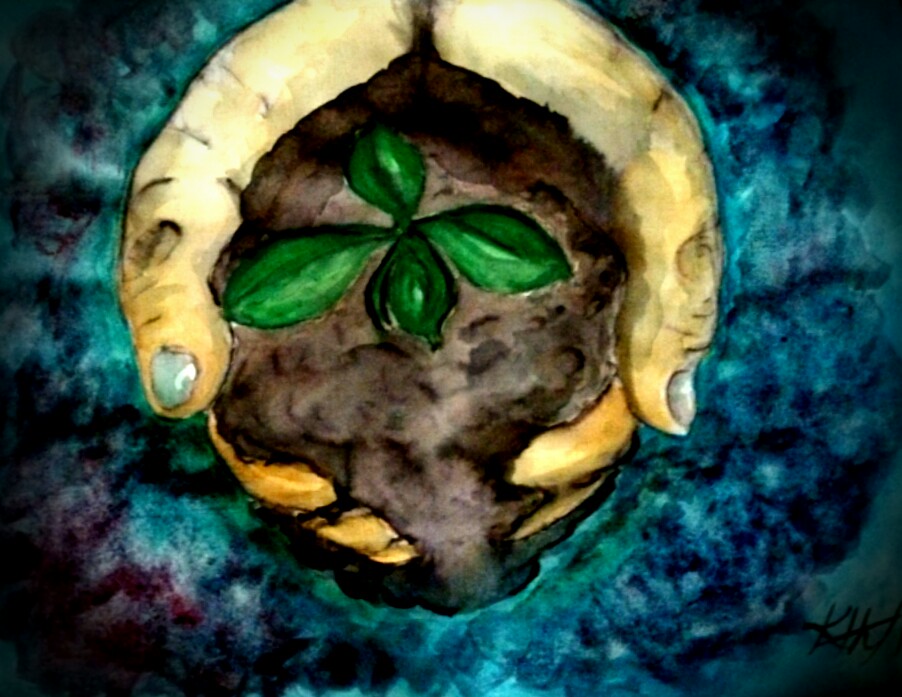 |
|
Written By: Keera Ratnam Manvaasanai is a new feature by Keera Ratnam that tells stories of back home. Keera is an avid artist and writer. Keera Ratnam was the recipient of the Top Talents 2013 Visual Arts Award. March 26 2012 Mother nature was not doing me a favor, the weather was sticky and humid. The change from 14 degrees to 38 degrees was too drastic for me to handle. I felt sweat drip down my temple making a trail that lead to the bottom of my ear. My eyes red, face swollen and limbs aching, all from the uncomfortable 10 hour transit at New Delhi Airport and lack of sleep since the day of my departure from Canada. I stood with all my backpack holding on to my father’s hand luggage. He was in deep sleep and didn’t even realize that we reached our final destination. I tapped him, “Appa…Appa…we’re here,” I said. He opened his eyes and looked at me. His eyes were red and his face was also swollen. He held on to my arm and tried standing up. His back was hurting and couldn’t stand properly. “Ennum konja thooram than ..Appa…elumpungo”. I told him we only had to walk a bit more. He smiled and took his luggage from me. My father was a darker gentleman. He was in his mid 60’s. He had difficulty walking on his own due to his spinal injury. There was a long line up, the only way in which we were told to assemble to depart the plane. As my father and I reached the exit, a air hostess from Jet airways wished us a good trip and helped my father down the stairs. As I came down the stairs I looked around and saw nothing but trees and cement. The air was extremely humid, but had no scent and no breeze. I felt like I was an egg frying in pan and at that moment only one thing came to mind was I just wanted to shower my self with ice cold water, this was the only way to freshen myself up. As we waited by the plane a streetcar pulled up to retrieve passengers, we got on. The streetcar lead us into the Sri-Lankan airport. It was definitely not what I had expected. It was small, but very clean. As my father and waited in line to show our visas and passports, my father asked me if I remembered this airport. I was young then my father said. He said, “I visited this airport twice, once when I was 18 months old and when I was 3 1/2 years old, when I migrated to Canada”. He remembers the day that he left my mother and I behind to migrate to Canada, and how we waved to him farewell in this very airport. Things changed over time he said. Yes, he is right, things did change but I was just too young to remember. As I glanced around I felt like as if I was at a shopping mall in Canada, but with very low air-conditioning. After clearing thing at the customs office, I headed down the escalator to retrieve my luggage. Stacking all of our luggage on one trolley, I told my father to follow me. As we walked to wards the exit an officer stopped my father asking to see his Sri-Lankan passport. I walked towards the officer giving him my fathers passport and told him that we don’t have Sri-Lankan passports. ” Oh you only have Canadian passports?” he asked. I nodded my head. ” You are only Canadian citizens?” he asked. “Yes”, I replied. He nodded and wished us the best of luck on our trip. As we walked across to passenger pick up I noticed that, those who had Sri-Lankan passports were asked to open up their luggage for inspection. I was amazed with the power of my Canadian passport and was happy that my belongings weren’t examined. At the passenger pick up my cousin and aunt waited for our arrival. My cousin noticed my father and waved his hand. I quickly pushed my trolley towards them and waited for my father to join. My cousin and aunt looked at me with happiness in their eyes. “It’s been 18 years my dear, we missed you so much” she said as she gave me a warm hug and a kiss on my forehead. My cousin whom I call Anna, meaning big brother took my luggage out side. Out side the air-conditioned Airport it was 10 times the heat. Wiping my sweat off my forehead, I took off my cardigan. Within 15 minutes our van pulled up in front of us. I sat in, removing my shoes and letting my feet breathe. Next stop, Vavuniya said my cousin with a smile.” Aaru manithiyalam edukum Vavuniya poha,” my aunt said. She was explaining to my father that it takes 6 hours to travel from Colombo to Vavuniya. I looked out side the window. I saw palm trees, coconut trees and colourful tropical flowers. It was a country filled with lots of vegetation. After a long six hours in the van, my cousin finally said that we have arrived at my aunt’s house. It was late at night, 10:15 pm to be exact. It was dark, but I could still see the silhouettes of the tree and houses. There were lanterns and small lights that helped view things in the dark. I stepped out of the van, holding my shoes in my hand and my backpack on my shoulder. I placed both feet on the ground, feeling the soft soil with my toes. It felt nice and moist. The air smelled fresh and sweet. It smelled like fresh soil, something that I could recognize but I wasn’t sure what it was exactly, but I knew I liked it.”How do you like it here so far?, asked my father.” “Its nice Appa I feel like Im at home, the air is sweet I can even smell the soil,” I said. ” Ithu thaan pillai manvaasanai” he told me. The smell of soil is what my father said, but it was something more than that. It was indeed the smell of the soil mixed with the sweetness of the palm trees and the warm air. But aside from the nature, it was symbolic, it held more value. It was the smell of home, a scent that I recognized because I was finally home after 18 years. This was something that Canada didn’t have and something money couldn’t buy, it was the smell of belonging. I felt it in the wind, saw it in the sky, touched it with my feet as I squished the mud and taste it in the air. I was definitely home. It is then that I realized that there is so much more that I have to learn, and understand. There is a lot to see and feel. I closed my eyes tight and took a breath. This is not a trip to reunite with my family, but where I will rebirth as I unravel my identity as to where I came from, who I am, and the history that my ancestors have carried. This is just the beginning. |
Thangachi’s Corner: Vanakkam—More Than Just a WordBy Admin - January 29th, 2014 |
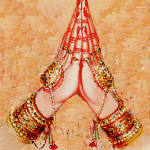 |
|
This post is part of the Tamil Heritage Month Initiative. Tamil Heritage Month seeks to celebrate Tamil heritage, culture, and history. Throughout this month and January, we will be providing you with educational material and poetry that seeks to help us celebrate and understand our culture, roots and heritage. January 29, 2014 Updated every other Wednesday, “Thangachi’s Corner” is a bi-monthly feature that discusses relatable topics and issues relevant to the Canadian Tamil youth of today. For more information about this feature or to suggest a topic, feel free to e-mail us at blogs@ctya.org! Written By: Keerthana Raveendran My Appappa doesn’t like the word, “Hi”. It sounds a bit odd, to have a vendetta against a two-letter greeting word used commonly in the English language. But Appappa doesn’t believe in “Hi” because he subscribes to the use of a slightly longer, five-letter word deeply rooted into our Tamil culture. And I don’t mean “Hello”. Ever since I was young, my brothers and I were taught to greet fellow Tamil folk not with a hello and a handshake, but rather with Vanakkam and a very famous hand gesture in which palms meet in a salute. Vanakkam (five letters in its Tamil spelling) symbolically signifies a greeting from the soul. While there are many different interpretations of the word and symbol, the most common one, and the one I grew up hearing, is that Vanakkam is a greeting between two souls, regardless of their status in life. The soul is viewed in a sacred manner, akin to God despite the age or character of its owner. While etymologically, the word Vanakkam stems from the root, “to bow”, referring to a respectful, reverent and worshipping gist, the greeting almost translates into a single phrase: “My soul bows to your soul”. It’s actually rather lovely when you stop and think about it. Vanakkam is a symbol of mutual respect between an adult and a child, between a rich person and a poor one, between a teacher and a student—it transcends man-made boundaries of classification to demand regard for every individual. Living in an almost exclusively Anglophone society Canada, it is difficult for us to maintain our Tamil language in casual conversation. But being a single word, Vanakkam is a very manageable step in the right direction. It not only immediately identifies us as Tamil, but also serves as a link to our Tamil heritage. So try not to hesitate in Tamil company—set aside your hello’s, bonjour’s and hola’s, put your palms together at your chest, and utter, as you greet one another, a warm and heartfelt: Vanakkam. |
Thangachi’s Corner: Celebrating Our HolidaysBy Admin - January 15th, 2014 |
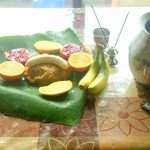 |
|
This post is part of the Tamil Heritage Month Initiative. Tamil Heritage Month seeks to celebrate Tamil heritage, culture, and history. Throughout this month and January, we will be providing you with educational material and poetry that seeks to help us celebrate and understand our culture, roots and heritage. January 15, 2014 Updated every other Wednesday, “Thangachi’s Corner” is a bi-monthly feature that discusses relatable topics and issues relevant to the Canadian Tamil youth of today. For more information about this feature or to suggest a topic, feel free to e-mail us at blogs@ctya.org! Written By: Keerthana Raveendran For some of us, yesterday was a regular day. We got up in the morning, went to either school or work, had a mediocre meal to go with our mediocre routine and managed to make it home in one piece. But for a lot of us Tamil folk, yesterday was special. We celebrated Thai Pongal, the harvest festival that takes place in early January to honour the sun, land and livestock for providing nourishment and sustaining our livelihood. Now, isn’t that something? Of course, when I say that we “celebrated” this joyous occasion, I really mean, “we cleaned our houses to Amma’s nagging and called it a day”. We probably even went to school like chumps. Maybe we took a short trip to the temple, or perhaps we ate some pongal, if we were lucky, but chances are, celebrations took place largely on the screen and less in life. We Canadian Tamils have a terrible habit of spending our holidays in lacklustre fashion. The work part? We’re great at that. We (or at least, some of us) will do the necessary cleaning, but when we get to the actual celebration, we are at a complete loss. If we had been raised back home, this holiday would have been a terrific festivity. We would have dressed up in new clothing, decorated our houses with kolam, and visited the temple. We might have made special dishes at home, would have also exchanged gifts with family and friends. Perhaps we may have even lit fireworks or attended special programs. Back home, Thai Pongal is legit. But here in Canada, we are exposed to a whole new set of challenges that makes slim our ability to celebrate the way our ancestors had. Restricted by Canadian law, we can hardly light fireworks wherever we want. Now, we are required to drive to temples rather than walk, and our kolam designs appear indoors rather than out, if at all. Living in a very mixed society, we do not necessarily cherish the same ûr of our parents—rather, the close sense of family and friends all celebrating the same traditions is transformed into one of Tamil folks desperately attempting to cling onto a solitary strain of culture amongst a colourful myriad of various other ethnicities. So how exactly do we celebrate, then? We are in a very different position from our ancestors. As one of the earlier generations of Tamil youth in Canada, we are presented with a marvellous opportunity—to craft our own traditions. We have both the occasion and the responsibility to raise awareness about our culture and to demand recognition for the holidays we celebrate. As youth, we can begin by exempting ourselves from school or asking for leave from work on major cultural landmarks such as Thai Pongal, in favour of cultural observance. After all, if festivities such as Christmas and Easter are nationally recognized, why not our holidays as well? Because we make up the early generation of Tamils in Canada, only we can create the new traditions that will make up our cultural holidays—consider it a social obligation, if you will. Who knows—maybe fifty years down the line, we’ll be the ancestors they talk about. About the Author: Keerthana Raveendran, known by her flock as Thangachi, is an aspiring author whose motivation to write usually kicks in when she’s supposed to be occupied elsewhere. She is an avid procrastinator who sees potential novel ideas as movies in her head. Maybe one of these days they’ll make it onto the page. Thangachi is currently a Masters student studying English at York University. |

